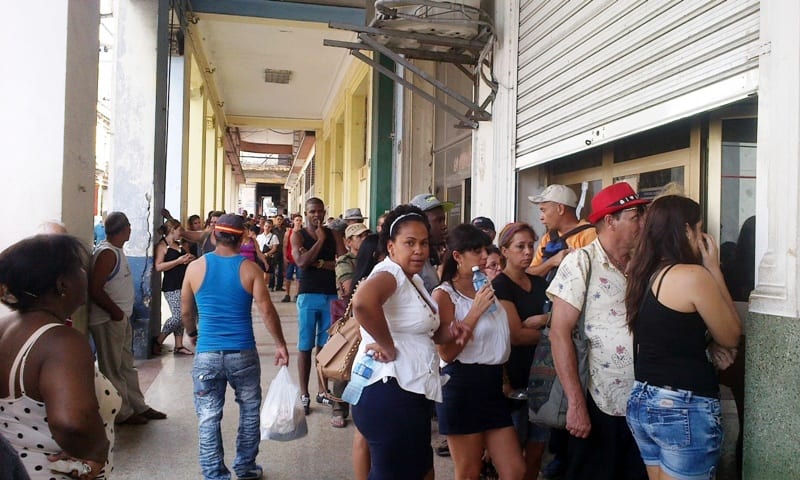It’s Getting Harder and Harder to Change Money in Havana
By Vicente Morin Aguado

HAVANA TIMES — The existence of two currencies as legal tender means that converting one for the other is a necessity, depending on the things you need to buy, while trying to save one’s meager salary at the same time. The current reality of the situation is that the much-needed conversion of these currencies has become a real challenge for the Cuban people.
Even though the government has been repeating its decision to eliminate the dual-currency system for several years now, the so-called “D-Day” can’t be seen anywhere on the horizon. The proclaimed policy of giving the regular Cuban Peso (CUP) a greater presence is counter-productive and limited, in fact people still need to change Convertible Pesos (CUC) for CUP and vice-versa, as an economic necessity for the majority of the population.
“For me it’s simple math, if a liter of soybean oil costs 2 pesos in hard-currency stores (TRD), they will charge me 50 Cuban pesos, I don’t understand then why they have two currencies circulating.” This was one of the interviewees’ responses; however, others added more revealing details. Waiting in a long line patiently to pay for her phone bill, a woman answered:
“I can pay services offered in CUC in CUP, at the 25/1 rate, but you can never do the opposite, that is to say, the fixed phoneline bill has to be paid for in CUP. This issue gets a lot more complicated because many of us use remittances or other income in CUC to pay, Cuba is very dollarized.”
It certainly is, so much so that the habit of calling CUCs dollars still exists, as these green dollar bills were what led to their creation, and the official exchange rate is 1/1, discounting a 10% tax punishing the use of the US dollar plus the standard bank commission.
[The 1/1 exchange rate is used in state-owned company accounting practices, which gives them imaginary profitability.]
People want to save and in order to do that, they need to convert their money: “Just imagine, at the CADECA – the government’s money exchange offices – they buy CUCs off of you for 24/1 and on the street for 23/1, you lose 1 or 2 pesos when you need to pay in national currency because the State only accepts it 25/1,” the interviewee explained. (With the small amount that Cubans earn that 4 to 8% loss is significant.)
Another person chimed in: “At the CADECA, you end up receiving 87.40 CUC for 100 US dollars, but the “fuleros” (money changers) on the street give you between $90-95 depending on whether they are large or small bills.” It just so happens that 50 and 100 dollar bills are the most sought-after. This dollars are often used by Cubans who travel to the United States, Venezuela or other countries in the Americas regularly, where the dollar is preferred. The outcome of this situation is a domestic market in Cuba for the US currency.
A young Irish man who was visiting the island and who had been here a few years ago and could speak Spanish well, gave his opinion: “I went to the Museo de la Revolucion with a Cuban friend, I was charged 8 CUC, a high figure but I decided to pay it. The Cuban had to pay the same but in regular pesos, I wanted to pay for him out of my own pocket, but it was impossible, they didn’t accept giving me back the difference in one currency or the other. After walking hurriedly through the surrounding streets, a bicitaxi gave me 20 CUP for a CUC and we resolved the issue badly.”
And so, the question arises: Why didn’t you go to an exchange office or a bank? Simple, there aren’t very many CADECAS left and banks are always full. For example, in Central Havana, with over 150,000 inhabitants, there are only two CADECAS that operate; at least 5 have closed down in recent years.
The consequence of this is long lines, waiting for your turn to exchange money. On the street, “fuleros” make up for the government’s inefficiency, but it’s always risky business, both for them, who are persecuted by inspectors and the police, as well as their clients in need as they could scam them on the conversion rate.
It’s better to try converting money at state-run or private businesses, but salesmen are set on only offering the 23/1 rate, as they aren’t responsible for the problem and plus, this is what young Alain claimed at a small cafe next to the Plaza de Cuatro Caminos: “After, I have to personally go and change the CUC for CUP, as you can’t ring convertible peso payments through the till, if a surprise inspection takes place you’ll get fined.”
Denied by the government with their tacit silence, it’s no secret that Cuba heavily depends on remittances from abroad and from daily business with tourists, activities which are marked by Convertible pesos. Finally, a new reason for worry has been added to our everyday drama in Cuba: changing money to ensure your survival.
Vicente Morín Aguado: [email protected]






The dual currency exchange rates are used primarily to subsidize the Zombie state enterprises. If is a highly inefficient model. It would be far simpler to directly subsidize these enterprises. In some cases, closing them would benefit the state.
I think the whole double currency is a hoax ;-)… http://bestcubatravelguide.com/double-curency-hoax/
Just give the guard at the Cadeca 5 CUC and you will never wait in line. I never have.
Like much else, it is a mess! Incompetence rules!